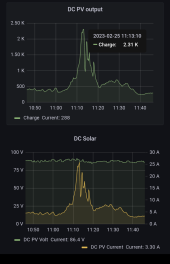stienman
Mostly Harmless
- Joined
- Jan 6, 2021
- Messages
- 477
Most electronic systems and parts, both consumer and professional, include hefty safety margins in their design and specifications:
Sometimes the true specifications are much more robust than the printed ones...
Human factors matter, and it seems to me that if most other specifications have a safety margin, people will naturally and reasonably get used to there being a general "safety margin" with most published specs.
Why not in this case?
Additional questions:
* are there other specifications which have no safety margin?
* since MPPTs are for Solar Panels, and Solar Panels have the property where their VOC can go UP in cold weather, is this simply a bad way to specify maximum voltages? E.g. maybe MPPTs should have to give their ratings for maximum VOC for a solar panel at 20,000 feet elevation, -40 temperature, and pointed directy at the sun?
These are weird assertions to make.
If you cross a bridge rated for 50 tons with a 60 ton load and it sustains damage, that's your fault. The bridge might not collapse, or the damage might not even be noticeable, but you've degraded it by going over its limit.
Because it's a human safety rated construction, though, and a public good, then the government demands that while it may sustain damage, it doesn't result in injury or death unless it's grossly exceeded. So you and the people under the bridge are going to be fine even though you've exceeded the rated limits.
But that does NOT mean that it's EVER ok to exceed them.
As far as human safety factors go, these inverters will, assuming they are UL rated, support an overvoltage condition of 2,000V.
They will likely be damaged, but they are not allowed to start a fire, cause an electrical shock, or spew harmful chemicals into dwellings.
So they do have a safety margin - but that's what it is - margin for the safety of the user and those around them, not a margin for the device's own safety.
Further, manufacturers have an incentive to advertise and document the operable maximum rating - you can buy a 250VOC controller to use with your 150V system and build that margin in yourself, but you're going to pay extra. If a manufacturer builds it and then rates it for only 150VOC, then they're paying for margin you don't need or want - and at the end of the day you are paying for it.
Lastly, these are maximum ratings not ideal ratings. If they've documented it correctly you'll find the MPPT controller performs its best at a specific voltage range. If you're constantly operating around its maximum then you're throwing power away. So if an MPPT controller has a maximum VOC at 150, it's operating range is likely 90V-120V. It'll operate outside that range, and it may even continue to perform the MPPT algorithm, but it'll do so at a lower efficiency than its design range.
So even if they over-designed it to handle 250VOC, wrote "Max VOC 150" in the documentation, if you're putting panels on it that get into that range, you're way outside the range they actually designed the components to operate best at.
The maximum VOC is a number you should make sure you don't exceed to avoid damage to the inverter.
But the entire solar system should be designed around the MPPT's operating range, and if your setup is within that range, then it's unlikely to exceed the maximum VOC.
This margin doesn't exist in most consumer products, and people aren't "used to" having a little extra headroom - except in safety critical applications. This is not one of those, and so unless you're equating the collapse of a building with the internal damage of a solar charge controller, you should not be assuming this either.
If you do think people are used to a little extra headroom, just ask around - "I see your laptop has a power adaptor with a 19.5V output, but this charger outputs 24V. Are you comfortable using it in your laptop?"



